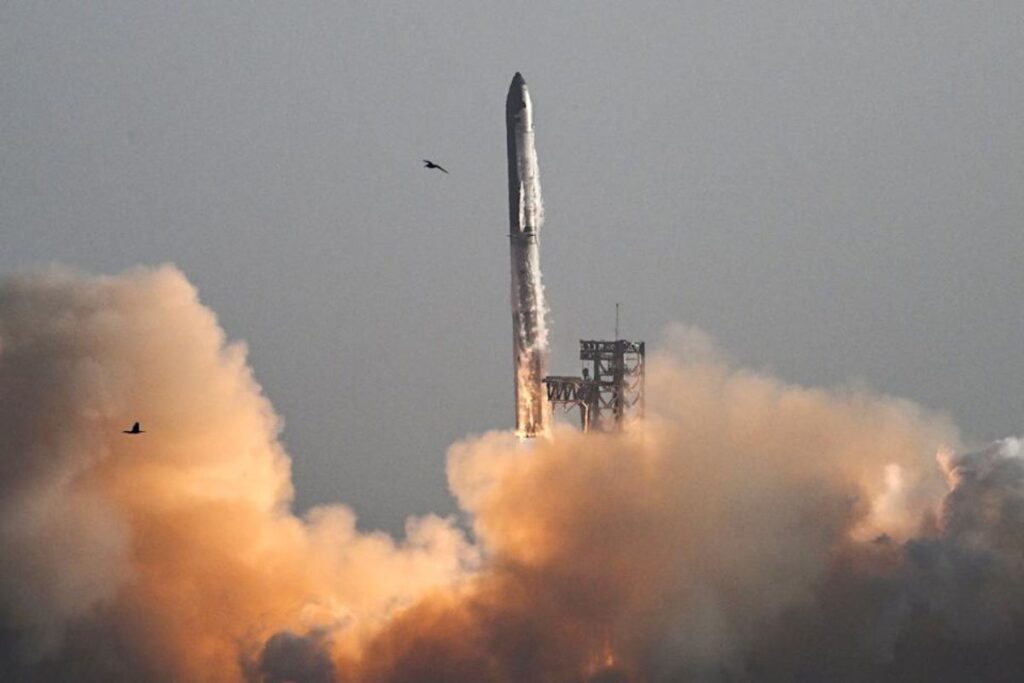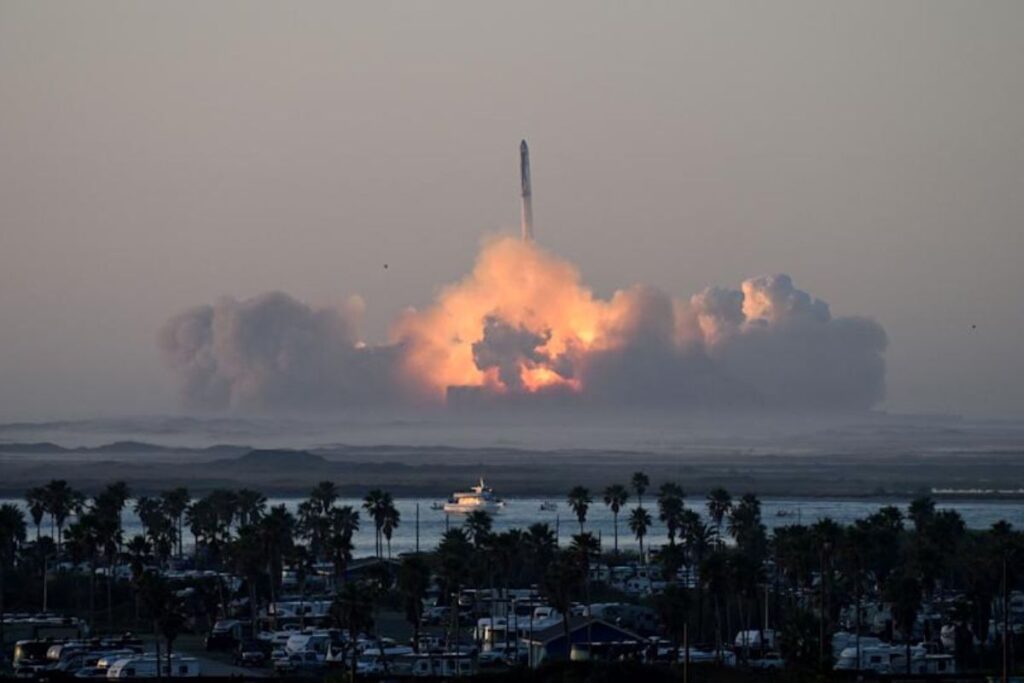SpaceX Starship Explodes Again: SpaceX’s ambitious Starship rocket lit up the Texas sky on Thursday, only to spin out of control and explode minutes later, marking yet another dramatic setback for Elon Musk’s spacefaring vision. Launched from Starbase in Boca Chica, Texas,
the Starship explosion sent debris tumbling over southern Florida and left the space industry buzzing about its ripple effects—especially for the budding prospects of SpaceX moon mining and lunar tourism. With companies banking on Starship’s power to unlock a lunar economy, this latest mishap raises big questions about the rocket’s future. Here’s what happened and why it matters.
A Fiery Ascent Ends in Chaos – SpaceX Starship
The Starship mega-rocket, a towering 400-foot beast, roared off the launchpad with the promise of pushing boundaries in space travel. This was its eighth test flight, and SpaceX had high hopes after nailing a booster catch in October 2024. But just as it reached the edge of space, things went south.
The upper stage spiraled wildly, lost contact with ground control, and erupted in a “rapid unscheduled disassembly”—SpaceX’s polite term for an explosion. Airports in southern Florida scrambled to enforce ground stops as wreckage streaked across the sky.
Read Also: Galaxy Z Fold 7 Delayed: Samsung’s Foldable Plans Stumble in 2025
This isn’t the first time Starship has gone boom. A similar fate struck its previous flight in January, scattering debris over the Caribbean. For a rocket pegged as the key to SpaceX moon mining and Mars colonization, these back-to-back blowups are more than just fireworks—they’re a wake-up call for an industry betting big on its success.
Why SpaceX Starship Matters for Moon Mining
Let’s talk about why this Starship explosion has folks on edge. SpaceX’s rocket isn’t just a flashy toy for Elon Musk’s Mars obsession—it’s the heavyweight champ the space world needs to turn the moon into a bustling hub. Unlike the Apollo-era Saturn V, which hauled 50 tons to the lunar surface, Starship can lug up to 110 tons, according to SpaceX president Gwynne Shotwell. That’s enough to carry habitats, drilling rigs, and even tourists to the moon—and bring them back.
Experts like Leroy Chiao, a former NASA astronaut who advised SpaceX for over a decade, call Starship “the most exciting thing” since the International Space Station. Eric Berger, a SpaceX chronicler, goes further: “It’s a technological leap most people don’t fully grasp.” Fully reusable and packing unprecedented power, Starship could slash spaceflight costs dramatically, making SpaceX moon mining and lunar tourism viable businesses—not just sci-fi dreams.
The Lunar Gold Rush Hangs in the Balance

The moon’s not just a pretty face—it’s a treasure chest of ice, minerals, and helium-3, a potential fusion fuel. Companies like Intuitive Machines and Firefly Aerospace, both Texas-based, are already testing the waters. This week, Firefly’s Blue Ghost landed on the moon with experiments to probe lunar soil, while Intuitive Machines’ Athena touched down with a drilling rig and cellular network—though it tipped over and cut its mission short. These are baby steps toward mining ice for water and fuel, a cornerstone of a sustainable lunar economy.
But here’s the catch: those heavy harvesters and habitats need a ride. “To sustain humans on the moon, you need big payloads—landers, equipment, the works,” Intuitive Machines CEO Steve Altemus told Business Insider. Starship’s reusable design promises to deliver that muscle at a fraction of the cost, unlike NASA’s pricey Space Launch System (SLS), which is drowning in delays and budget overruns. If SpaceX moon mining is to take off, Starship has to stick the landing—literally and figuratively.
What Went Wrong This Time?
Thursday’s Starship explosion isn’t fully explained yet, but the signs point to trouble with the upper stage. After the Super Heavy booster separated and returned to Earth (a win SpaceX has mastered), the Starship spacecraft lost its mojo. Multiple engines shut down, it spun out, and boom—game over. Musk hasn’t commented directly on this flight, but after a similar flop in January, he pinned it on an oxygen-fuel leak. SpaceX says it’s digging into the data to figure out what tanked this time.

The pattern’s troubling. While the booster’s reusable catch is a triumph, the spacecraft itself has only splashed down in the ocean after spaceflights—not landed intact on solid ground. That’s the holy grail SpaceX needs to recycle Starships and keep costs low. Until they nail it, the lunar economy—and Musk’s Mars dreams—stay grounded.
SpaceX’s Rivals and NASA’s Stake
SpaceX isn’t the only player in the lunar lift game. Blue Origin’s New Glenn rocket, fresh off its first orbital flight in January, could haul heavy loads to the moon, too. But it’s years behind Starship, and only its booster is reusable—not the whole shebang. NASA’s SLS, meanwhile, has flown once around the moon uncrewed, but it’s so bogged down that some insiders predict cancellation. Boeing, its builder, is bracing for that possibility, per Ars Technica.
NASA’s already hitched its wagon to Starship, contracting SpaceX to land astronauts on the moon by 2027—the first boots on lunar soil since 1972. Musk’s timeline is even bolder: crewed Mars flights in four years. Both dates have a habit of slipping, though, and this Starship explosion doesn’t help. If SpaceX can’t deliver, NASA might lean harder on Blue Origin or rethink its lunar strategy altogether.
The Bigger Picture: A Lunar Economy at Risk?
Zoom out, and this isn’t just about one rocket—it’s about the future of space. A working Starship could kickstart a lunar gold rush, with companies mining resources to fuel bases, power spacecraft, and even support tourism. Imagine sipping a lunar latte while watching Earth rise—crazy, but possible with Starship’s heft. Berger calls it “revolutionary no matter what,” even if full reusability remains elusive.
But these explosions are a reality check. “Maybe Starship will never nail rapid reuse,” Berger cautions. If it falters, the lunar economy could stall, leaving moon mining as a distant dream. SpaceX’s “move fast and break things” mantra has gotten them far—booster catches are proof—but the upper stage’s woes show there’s still a long road ahead.
What’s Next for SpaceX and Starship?
SpaceX isn’t throwing in the towel. They’ve got a knack for learning from crashes, and Thursday’s data haul will fuel tweaks for the next test. Musk’s team has already upgraded Starship’s flaps, computers, and fuel systems since last year. The goal? A spacecraft that can soar to space, land gently, and fly again—pronto. Whether that’s months or years away, though, is anyone’s guess.
For now, the space community’s watching with bated breath. NASA needs Starship for its Artemis program, companies need it for SpaceX moon mining, and Musk needs it for his Martian legacy. Another explosion won’t kill the dream, but it sure makes the timeline fuzzier.
Your Take: Is SpaceX Starship the Lunar Key?
This Starship explosion has us wondering: can SpaceX pull off the lunar leap, or are we overhyping Musk’s mega-rocket? Are you rooting for SpaceX moon mining to kick off a new space age, or do you think Blue Origin or NASA might steal the show? Share your thoughts in the comments—let’s get this cosmic convo going! And if you’ve got a hunch on when Starship will finally stick the landing, we’re all ears.
Read Also: Siri Upgrade Delayed: Apple’s Personalized AI Dream Hits a Roadblock
Conclusion: A Bumpy Ride to the Moon
As of March 08, 2025, the latest Starship explosion is a gut punch for SpaceX, but it’s not game over. The rocket’s potential to revolutionize space travel—and unlock SpaceX moon mining—is still alive, even if it’s limping. With every fiery flop, SpaceX inches closer to cracking the code. Whether that’s in time for NASA’s 2027 lunar landing or Musk’s Mars vision, one thing’s clear: the road to the stars is paved with explosions, ambition, and a whole lot of grit.

